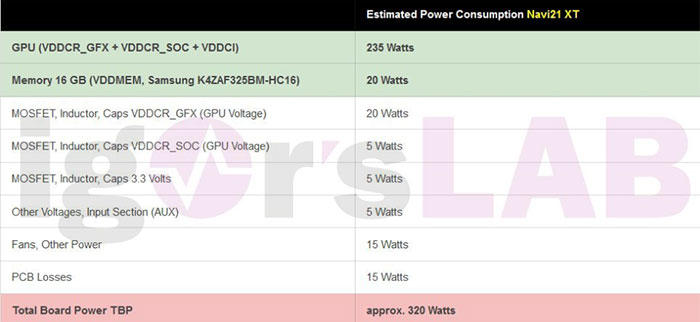Over the weekend there was quite a bit of excitement over leaks indicating that the top-end AMD Radeon RX 6000 Series graphics cards could boost up to 2.4GHz. Alongside these GPU clock speed assertions, from a PC developer insider and regular Twitter leakster with a good track record, we saw some 'TGP' figures for the AMD Navi 21XT.
Igor Wallossek of Igor's Lab, and Editor in Chief Toms Hardware Germany, has a good reputation for revealing pre-release CPU and GPU info and he does it with a lot more depth than the Twitter based sources. Igor says he has had some background info on the AMD Radeon RX 6000 Series, noted the weekend leaks, but held fire to get some confirmation from sources and to provide a better power consumption comparison against the likes of the GeForce RTX 3080 - which despite being difficult to actually purchase is a known quantity.
Importantly, Igor says that Patrick Schur's weekend revelations were correct but some media, observers and enthusiasts apparently misinterpreted the 'TGP' figures as being directly comparable to the 'TBP' figures of the GeForce RTX 3080, for example. In brief, AMD's 'TGP' figures account for only the power dissipation to be cooled as generated by the GPU and memory. Thus the 255W 'TGP' figure for GPU and memory power usage needs to be added to, quite significantly, to calculate the graphics card 'TBP' (Total Board Power).

Above you can see Igor's estimated power consumption for a graphics card powered by the Navi 21 XT GPU. In green you can see the 255W total consumption by the GPU and memory (235W + 20W). However, once you add in all the other essential power consuming board components like MOSFETs, cooling and so on, it is estimated that a further 65W is required. This means that "the actual power consumption of the Navi21 XT should be about the same level as that of the GeForce RTX 3080," according to Igor's Lab.
Availability of AMD Radeon RX 6000 graphics cards
Igor teases that those waiting to purchase AMD Navi 2 graphics cards from next month "may be pleasantly surprised". AMD board partners haven't had a particularly difficult time, he asserts, as they can copy and paste many of the Navi 1 board design features. Elsewhere it is noted that early drivers have "completely limited the graphics performance to avoid annoying leaks," but I'm not sure why this would be a good thing for AIBs trying to optimise their designs for real-world use.













